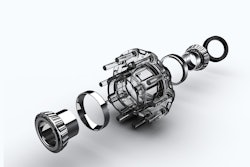By John Blodgett, vice president of sales and marketing, MacKay & Company
In last month’s Truck Parts & Service, Lucas Deal wrote a good article on the opportunity for distributors to grow their aftermarket business with trucks used in the agriculture market. As I work for a company that spends a lot of time profiling the aftermarket for replacement parts and services for both on- and off-highway equipment, I thought I would use this month’s column to provide some more context to Lucas’s article. (And thanks, Lucas, for allowing me to piggyback off your article.)
Lucas is right: If you are a distributor in a rural or semi-rural area you should not overlook the opportunity related to trucks used in agriculture, and you may want to also consider possibilities related to the off-highway equipment used on farms. I am not talking about becoming an expert in agriculture equipment, but there are a lot of parts (belts, hoses, filters, etc.) that would likely not involve being an agriculture equipment expert to expand your product offering.
MacKay & Company estimates there is a $5.3 billion aftermarket parts opportunity for on-highway vehicles (Class 2-8) used in agriculture. While this is only 9 percent of the total parts aftermarket, there is still a lot of potential there. This includes parts for large pickups, tractors and trucks that move unprocessed food goods, such as milk, and take grains to rail heads or grain elevators or move livestock. In total, including trailers, there are a little more than two million vehicles driving this market-specific aftermarket.
In the off-highway market for agriculture equipment, MacKay & Company has a service called DataMac Ag, which profiles the aftermarket for replacement parts used on mobile farm field equipment. The aftermarket demand for parts on this type of equipment is about $7.6 billion a year, with most of that demand coming from farm tractors. Granted, not all product areas are likely going to be of interest to a company whose primary business is the truck after-market, but 12.5 percent of that $7.6 billion comes from maintenance parts and electrical parts (such as alternators, starters, and batteries).
Auto parts stores are an example of a distribution channel that has established a good presence in this market as well as the on-highway market beyond automobiles. As farm equipment dealers stopped having a dealer in every town, the NAPA’s, Carquests and O’Reilly Auto Parts of the world have done a good job of filling this niche for many of the parts farmers previously got from equipment dealers. Auto parts stores represent almost 8 percent of this aftermarket, close to the 9 percent they have for the on-highway market.
Farmers do more of their own service work than others (that means they make the majority of the decision of where needed parts are purchased). They tend to have older and used on-highway equipment and a wide age range of farm equipment. The average tractor is over 20 years old. You probably currently have some agriculture business customers, sometimes called farmers, and you probably have some farmers that work for you if you are in a rural community.
I would start with them to under-stand where there might be some more opportunities to expand your business. Farmers may be driving past your business today, traveling to the next town to get that filter they need for their tractor—why not save them some time and help your bottom line?
John Blodgett has worked for MacKay & Company for more than 20 years and is currently vice president of sales and marketing, responsible for client contact for single and multi-client projects. He can be reached at [email protected].











